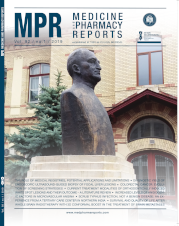Increased levels of Angiogenic Factors In Microvascular Angina
DOI:
https://doi.org/10.15386/cjmed-1101Keywords:
angiopoietin, cardiac syndrome X, metoprolol, tyrosine kinaseAbstract
Background. Recent studies have suggested that angiogenic factors may affect vascular endothelial integrity. On the other hand, endothelial dysfunction is the main pathological mechanism in microvascular angina (MVA) or cardiac syndrome X. Therefore, we aimed to determine the levels of angiogenic factors in MVA patients. In addition, we investigated the effects of metoprolol, as a beta blocker agent, on the serum levels of these factors.
Methods. Thirty patients with MVA (17 female/13 male; mean age: 55.53±9.18 years) and twenty healthy controls (14 female/6 male; mean age: 51.40±9.16 years) were enrolled.
The serum amounts of angiopoietin-1 (Ang-1), angiopoietin-2 (Ang-2) and tyrosine kinase-2 receptor (Tie-2) were measured in healthy controls, MVA patients at baseline and after metoprolol therapy (25 mg for one month) by enzyme-linked immunosorbent assay.
Results. The levels of Ang-2 and Tie-2 were significantly higher in MVA patients at baseline in comparison with controls (Ang-2: 277.02±186.08 vs.164.46±49.83 ng/l, P=0.011; Tie-2: 28.97±18.85 vs. 14.90±4.05 ng/ml, P=0.002; respectively). But this difference in the Ang-1 levels was not significant (P=0.829). Additionally, the levels of angiogenic factors in MVA patients after metoprolol therapy were not significantly changed in comparison with the baseline status (P>0.05).
Conclusion. Our results considered a possible role for angiogenic factors in the pathophysiology of MVA, which need further investigation for elucidation. In addition, this study has not showed an effective role for metoprolol in changing the angiogenic factors levels as a therapeutic agent in MVA.
Downloads
Published
How to Cite
Issue
Section
License
The authors are required to transfer the copyright of the published paper to the journal. This is done by agreeing to sign the Copyright Assignment Form. Whenever the case, authors are also required to send permissions to reproduce material (such as illustrations) from the copyright holder.

The papers published in the journal are licensed under a Creative Commons Attribution-NonCommercial-NoDerivatives 4.0 International License.

